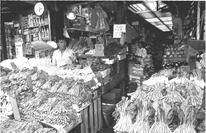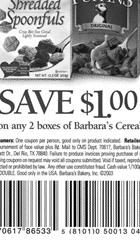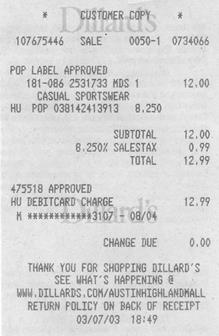Unit 2. The things I like and Dislike. My Shopping.
 Money is an article which may be used
Money is an article which may be used
As a universal passport to everywhere except
Heaven, and as a universal provider
Of everything except happiness.
Wall Street Journal
Two women make a market;
Three make a fair.
Recommended grammar: Ukrainian proverb
Reported Speech.
BUILDING-UP YOUR VOCABULARY
|
Hours of Business
Most shops in the United States open at 9:30 or 10:00 a.m., Monday through Saturday, and close between 5:00 and 6:00 p.m. Larger stores are often open until 9:00 p.m. during the week, and from 10:00 a.m. till 5:00 p.m. on Sunday. Offices tend to have business hours between 9:00 a.m. and 5:00 p.m., Monday through Friday.
Sales Tax
 Cities and states have the right to charge an additional percentage of the cost of some items in order to raise revenues. In most places, a sales tax of up to 10% of the price is added to the bill for many non-food items. Taxable items may include prepared food, technical equipment, books, records, clothing, cigarettes, alcoholic beverages, paper products, household products, appliances, cameras, and film. You should be aware that the prices listed on items in stores do not include sales tax. Sales tax will be added to your bill by a cashier.
Cities and states have the right to charge an additional percentage of the cost of some items in order to raise revenues. In most places, a sales tax of up to 10% of the price is added to the bill for many non-food items. Taxable items may include prepared food, technical equipment, books, records, clothing, cigarettes, alcoholic beverages, paper products, household products, appliances, cameras, and film. You should be aware that the prices listed on items in stores do not include sales tax. Sales tax will be added to your bill by a cashier.
Making a Purchase
When entering a store, you may be asked to leave bags,
backpacks, or large purses, etc. with a store clerk behind a
counter. You should retrieve your bag as you exit the store,
after you have completed your purchases. To purchase items
in stores in the U.S., you should bring the items you wish to
purchase to a cashier. The cashier will total the cost of the
items you wish to buy using either the price written on the
item itself, or a bar code which is electronically scanned for
a price code stored by the cash register. When the cashier
totals all the items and adds any applicable tax, you should
then pay for your purchase. The cashier will put the items in a plastic or paper bag and hand it to you. The cashier may also staple the bag shut for security reasons.
Many newspapers provide coupons that offer discounts on certain items. Check expiration dates at the bottom of the coupons before using them. Present them to the cashier before your items are totaled.
|


|
a) Food Shopping
Food shopping in the U.S. can be done in four main types of stores: supermarkets, grocery stores, convenience stores and delis.
Supermarkets, the largest of these, departmentalized, self-service stores carry a wide variety of edible items- dairy products, cereals, bread and baked goods, prepared, canned and frozen goods, ice cream and dessert foods, beverages, and non-edibles - paper products (toilet paper, facial tissue, paper plates and napkins, etc.), personal care products, cigarettes, film, housewaresand non-prescription drugs. Some supermarkets also have salad bars, film developing services (in general, it costs about $7.00 or $8.00 per roll of 24 exposures for developing and standard prints) and pharmacies. Depending on a state’s laws, supermarkets may also carry wine and beer. Prices of items are usually clearly marked on the packages, or on signs near the items. Supermarkets usually have baskets and carts for carrying items around the store. They generally have several cashiers and use both manual and electronic pricing scanning (the cashier passes a coded tag in front of an electronic scanner and a price is automatically entered into the cash register). In general, supermarkets are open from Monday to Friday from 9 a.m. to 6 p.m., and on Saturday from 10 a.m. to 4 p.m. Some supermarkets are open on Sundays as well. Many supermarkets are now open 24 hours. Most supermarkets are either closed on major holidays, or are open fewer hours. The general consumer appeal of the supermarket concept — large size, self-service, variety of merchandise, one-stop shopping, ample parking, and low prices — ensured their growth. The building of such stores in suburban areas was important in the development of the retail complexes that came to be known as shopping centers, or malls.
Today, supermarkets are operated by chains of various sizes and by independent owners. The supermarket concept is gaining increasing popularity throughout the world. Other lines of retailing have adopted some of the supermarket methods of low-cost mass distribution.
Grocery stores, a bit smaller than supermarkets, may carry most of the same types of products, but in smaller quantities and with less variety (for instance, they may not have a large selection of fresh vegetables; or they may sell only one commercial brand of a particular item). Grocery stores do not usually have film developing services or pharmacies. Depending on a state’s laws, grocery stores may also carry wine and beer. Prices in grocery stores are usually similar to those of supermarkets. As in supermarkets, the prices of items are usually clearly marked on the packages, or on signs near the items. Grocery stores also usually have baskets and carts and several cashiers. In general, grocery stores usually keep the same working hours as supermarkets.
Convenience stores (called this because of their hours of operation - usually from at least 7:00 a.m. to 12:00 p.m. and sometimes 24 hours a day) carry a very limited selection of goods and brands. These stores may carry some canned, prepared and frozen goods, beverages, breads and baked goods, and paper and health care products. Prices for items can sometimes be twice that of supermarket prices. When prices are not marked clearly, it is a good idea to ask about the prices of items before the cashier totals the items you wish to purchase.
Delis usually carry only cold cuts (sliced ham, turkey, salami, chicken, roast beef and cheese, etc., prepared for use in sandwiches), breads, beverages, and condiments. Some delis also carry selections of prepared foods and other items.
Other types of specialized food storesinclude baker’s/ bakery, butcher’s, confectioner’s/ confectionery, dairy, greengrocer’s, fishmonger’s, fruiterer’s, sweet-shop, off-license shop/ wine and spirit merchant’s, and tobacconist’s.
|
florist's greengrocer's baker's
butcher's tobacconist's pet shop
grocer's newsagent's antique shop
stationer's
|
General vocabulary:
retail, wholesale, shop/ store, chain, mail-order firm, booth, stall (kiosk), rag fair, shop-window / window display, to dress shop window, show-case/ case/ glass cabinet, counter, check-out point, cash-desk, salesman/ saleswoman/ shop assistant, customer /shopper/ consumer, consumer goods, shopping queue/ line, to do one's shopping/ to go shopping, shopping spree [spri:], impulse buying, bargain, to buy/ to purchase/ to shop for, to sell/ to supply/ to deliver (goods), to display (goods), to be in (full) stock, to be out of stock, cheap, expensive /dear, to cost, price, at a price, discount, at a discount, sale, sales tax, mark-down, boutique [bu'tik], scales;
open from 9 am to 6 pm; Monday to Saturday; closing (opening) time;
to attend (to)/ to serve, to be attended to / to be served, to wrap, fitting /changing room;
to try on, to be stock size, to take size...gloves collar, to wear shoes size ..., to be dress size ..., to fit, to be a misfit, to suit/ to become, to match/ to go with, to look (well);
style/ design, cut, fashion /vogue, to come into fashion, all the vogue/ all the rage, up-to-date, stylish, dowdy, drab,
to be long-wearing, to wear well, to be shrink proof, to be colour-fast / fade proof, to be shower proof / waterproof/ water repellent, to be crease-resistant, to wash well, to dry soon, to afford;
to run out of smth. to run short of smth. - I've run out of flour.
to stock up - I usually stock up for the week on Saturdays.
to be well stocked,
that will do, will this do? - I'd like a couple of big apples. - Will these do?
we've just got/had.....in,
to be out of stock to have sold out - Have you got vinegar? - We've sold out/we're out of stock.
to buy/sell....loose/ piecemeal;
to sell smth. by weight/by the head;
I’m 91-61-91 (i.e. 91 centimeters round the bust, 61 round the waits, 91 round the hips).
He’s grown out of his shoes.
Adjectives describing price and attitude to money:
free, cheap, reasonable, quite /very/ incredibly expensive, skinflint, thrifty;
Words and phrases about money:
to spend money on smth., at a price, to pay for, to cost, to charge (He charged me $100 = He asked me to pay $100), to lend, to borrow, to waste, to save up, to change, change, to buy on credit/installments, pay a deposit of … pounds;
How much is it? / What does it cost?/ What's the price of...? /What price is this...?/ How much is this watch worth?/ What is the value of it? – It’s worth about $50.
How do you pay? – (In) cash/ by cheque/ check/ by credit card.
Women's outfitter’s or Men's outfitter's:
This skirt is too tight and too short – it needs letting out and letting down.
The dress is too loose and too long – it needs taking in and taking up.
Ready-made clothes/ Ready-to-wear/ Off-the-peg:
garments, dress /frock, gown, pinafore dress, dressing-gown, housecoat, blouse, skirt, shirt, trousers/ pants, slacks, jeans, suit, lounge suit, jacket, dinner jacket (AmE tuxedo), tailcoat/ tails, coat, fur-coat, raincoat /mackintosh, parka, wind jacket, wind cheater, (AmE wind breaker);
Sports shop /sports outfitter's:
sportswear, sport equipment;
Shoe shop /Footwear:
shoes, pumps, boots, high fur-lined boots, wedge-heeled shoes, shoes with high stiletto heels, shoes with no pointed toes, shoes with long pointed toes, laced (shoes, boots), sandals, slippers/trotters (AmE mules), shoes with a zip, covershoes / galoshes (AmE rubbers), Wellingtons, trainers, running shoes, tennis shoes;
suede / chamois, patent-leather, canvas shoes, leather-soled, rubber-soled, flat-heeled (with flat heels), high-heeled, with a small buckle, with a narrow bow, shoe horn, shoe polish;
to have wide/ narrow feet, to have fallen/ high arches;
I have a high instep so I am only comfortable in a low-cut shoes.
I’ve rather a broad foot.
Milliner's:
hat, cap, beret, panama hat, sun hat;
Knitted goods /wear:
cardigan, sweater, jumper, pull-over/ jersey;
Hosiery:
socks, stockings, tights /panty-hose, knee-high stockings, knee-length socks;
Linen:
sheet, pillow-case, blanket slip, bed-cover, table cloth, napkin;
Women’s underwear:
lingerie, slip, waist-slip, bra /brassiere, panties, briefs, bikini briefs, vest;
Men's underclothes:
sleeveless vest, short-sleeved vest/T-shirt, briefs, trunks, long Johns;
Jeweller’s:
ring (engagement ring, wedding ring), ear-rings, necklace, brooch, pendant, bracelet, anklet, silverware;
Perfumery /Cosmetics:
perfume / scent, cream, lipstick, varnish, powder, eye-shade, mascara, make-up;
Style:
long-sleeved, V-necked, round-necked;
General description of clothes:
elegant, smart, scruffy, chic, trendy, with-it;
Appearance:
impeccable, well-dressed, badly-dressed, old-fashioned, fashionable;
Textiles:
satin, velvet, cotton velvet, cotton, nylon, serge (for lining), print, linen, pure-wool cloth, tweed, silk (natural, artificial), leather, kid, tartan, stockinet / knitted, lace, fringe;
Patters and colours:
plain/ solid (AmE), flowered, background, striped, pin-striped, tartan/ plaid (AmE), chequered/ checkered (AmE), polka dot /dotted, spotted, zigzag, rich colour, carmine, coral, crimson, pinkish, purple, beige, copper, khaki, pistachio, azure;
Haberdasher's:
thread reel, yarn, tape, ribbon, needle, knitting-needle, pin, safety-pin, button, hooks, clasps, gloves, mittens, muffler/ scarf, toiletries;
Antique shop and art shop:
valuable old articles, bric-a-brac, painting, water-colour, engraving, etching, sculpture, books on art;
Record shop and newsagent's:
records,newspapers, magazines, posters, paperbacks, greeting cards, plain/picture postcard, envelopes, stamps;
Chemist's /druggist's/ drugstore:
drugs /medicines and related articles;
Bookseller's /bookshop and Stationer's (AmE stationery):
note paper, writing paper, writing pad, wrapping paper, carbon paper, notebook, file, diary, paper clip, drawing pin, ruler, rubber/ eraser, fountain pen, ink, ball-point pen, refill, fibre / felt-tip pen;
Florist's /flower shop:
plant,pot plant, wreath, bouquet ['bukei], seed;
Furniture shop:
bedroom suite [swi:t], sitting-room suite, blind, curtains;
Ironmonger's /hardware shop:
spade, nail, hammer, screw, nuts, screwdriver, gardening tools, watering-can, bucket / pail;
China shop:
china /porcelain, glassware, pottery /ceramics, crockery (ware);
Household goods:
tableware, dinnerware, kitchen utensils, iron, broom, mop, electric appliances.
|
Non-Food Shopping
Malls are the places where many Americans go to shop for all kinds of goods. A mall is a large building containing many different kinds of stores, including big department stores and small specialty stores. Specialty stores sell everything from electronics to cosmetics to imported coffee. Malls are usually indoors, but some “strip malls” are outdoors.
Department Stores are large stores where you may purchase items such as jewelry, perfume, clothing, shoes, appliances, televisions, radios, bicycles, furniture, etc. You may also find some personal care and food products, as well as film processing in department stores. While most merchandise is kept on easily accessible shelves, some small valuable items (such as watches, cameras and jewelry) may be kept in locked glass cabinets. You may ask to see and examine most of these items. The procedure for purchasing merchandise is the same as the one in most other stores: you bring the merchandise to a cashier's counter; the cashier totals the cost of the merchandise; and you then pay the cashier. The cashier usually hands you the merchandise in a plastic or paper bag.
Discount Stores such as Wal-Mart, K-Mart, and Target can be found in most cities and towns. These are very large stores that usually offer department store items and some grocery items at lower prices. They are able to offer lower prices because they offer fewer services and less attractive shopping areas.
Campus bookstores carry textbooks required for classes, as well as supplies such as notebooks, pencils, pens, folders, etc. Campus bookstores also carry stationery and gift items.
Drugstores sell medications. There are two types of drugs available, over-the-counter and prescription only. Prescription drugs require written permission from a doctor in order to obtain them. Over-the-counter drugs such as aspirin, cold medicine and stomach medications can be bought without first seeing a doctor and are available at almost any type of food or drug store. If you get a prescription from a doctor, you should go to a place which has a pharmacy to get your medications. Drug stores in the U.S. often carry more than pharmaceutical supplies. You may also find personal care products, perfume, non-prescription drugs, film, cigarettes, small appliances, greeting cards, and gift items. Some drug stores also carry some food products and have film processing services.
Liquor Stores. In some states, it is legal to sell beer and wine in supermarkets, grocery stores, convenience stores and delis. In other states, beer, wine and liquor are sold only in liquor stores. Liquor stores in many states are closed on Sundays. State laws restrict the purchase of alcoholic beverages to people aged 21 and over. Stores, restaurants and other establishments are subject to strict fines and penalties if they sell alcoholic beverages to people under 21. Therefore, in order to purchase these items, you may be asked to show a picture identification card. Also, it is illegal to have an opened container of beer, wine or liquor in a car or other public places like sidewalks, parks and buildings. Alcoholic beverages must be consumed in private homes, in restaurants, and other such places which have a license to serve liquor.
Questions:
1. What is the difference between malls, department and discount stores? Are there any stores of these kinds in your city? Do they have similar or different features compared to the American stores?
2. Are there any campus stores in your city? Where do students (ordinary people) usually buy books for studies?
3. Do you need a prescription to buy medicine at American drugstores? What about the situation in Russia?
4. Where can people in Russia buy liquor? Where do Americans buy it?
5. How do laws in the US restrict purchase of alcohol? Are there any similar laws in Russia?
|
a) cash desk sales tag label off-the-peg
